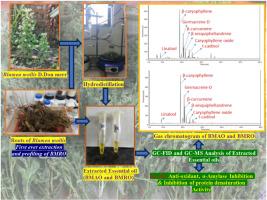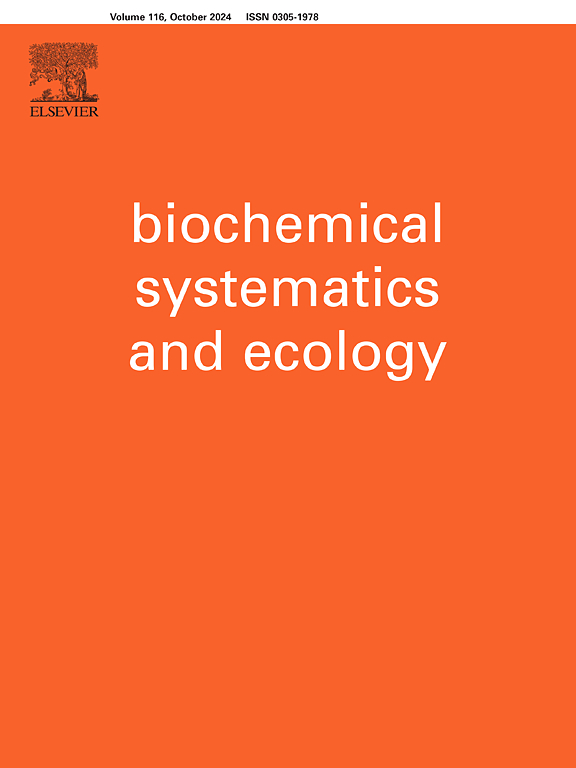Chemical profiling and bioactivity analysis of shoots and roots essential oil of Indian Blumea mollis D. Don (Merr.)
IF 1.4
4区 生物学
Q4 BIOCHEMISTRY & MOLECULAR BIOLOGY
引用次数: 0
Abstract
Aromatic plants contain essential oils, potent extracts renowned for therapeutic benefits. Essential oils are commonly utilized due to their diverse range of phytochemicals that possess therapeutic properties. The present study analyses the chemical composition of the essential oil obtained from shoots and roots of Blumea mollis (Family: Asteraceae), using GC-FID and GC-MS techniques. A total of 49 and 46 compounds were identified from shoots and roots accounting for 95.6 % and 88.4 % respectively. β-caryophyllene is reported as major compound 36.2 ± 0.50 % in essential oil of the shoots and 33.8 ± 0.55 % in essential oil of the roots. Both essential oils of shoots and roots were dominated by sesquiterpene hydrocarbons (59.2–76.4%), followed by oxygenated sesquiterpene (14.9–20.3%). The in vitro antioxidant activity was determined using DPPH radical scavenging activity, H2O2 radical scavenging activity, and Iron(II) complexing activity. The highest antioxidant activity was observed in root essential oil of B. mollis. The oils also inhibited the activity of α-amylase with IC50 of 3.53 ± 0.04 μg/ml (shoot), 3.45 ± 0.04 μg/ml (root). Root oil also showed good activity for protein denaturation with IC50 of 3.02 ± 0.03 g/ml as compared to shoot essential oil. This is first time that essential oil constituent and biological activity of B. mollis roots and shoots have been characterized from India.

印度昙花(Blumea mollis D. Don (Merr.))嫩枝和根部精油的化学特征和生物活性分析
芳香植物含有精油,这些有效的萃取物以治疗功效著称。精油中含有多种具有治疗功效的植物化学物质,因此被广泛使用。本研究采用 GC-FID 和 GC-MS 技术分析了从 Blumea mollis(菊科)的嫩枝和根中提取的精油的化学成分。从嫩枝和根中分别鉴定出 49 种和 46 种化合物,所占比例分别为 95.6 % 和 88.4 %。据报告,β-石竹烯是嫩枝精油中 36.2 ± 0.50 % 和根精油中 33.8 ± 0.55 % 的主要化合物。嫩枝和根的精油都以倍半萜碳氢化合物为主(59.2-76.4%),其次是含氧倍半萜(14.9-20.3%)。体外抗氧化活性是通过 DPPH 自由基清除活性、H2O2 自由基清除活性和铁(II)络合活性来测定的。莫利根精油的抗氧化活性最高。精油还能抑制α-淀粉酶的活性,IC50 为 3.53 ± 0.04 μg/ml(嫩枝)和 3.45 ± 0.04 μg/ml(根)。与嫩枝精油相比,根部精油对蛋白质变性也表现出良好的活性,IC50 为 3.02 ± 0.03 g/ml。这是印度首次对 B. mollis 根和芽的精油成分和生物活性进行表征。
本文章由计算机程序翻译,如有差异,请以英文原文为准。
求助全文
约1分钟内获得全文
求助全文
来源期刊

Biochemical Systematics and Ecology
生物-进化生物学
CiteScore
3.00
自引率
12.50%
发文量
147
审稿时长
43 days
期刊介绍:
Biochemical Systematics and Ecology is devoted to the publication of original papers and reviews, both submitted and invited, in two subject areas: I) the application of biochemistry to problems relating to systematic biology of organisms (biochemical systematics); II) the role of biochemistry in interactions between organisms or between an organism and its environment (biochemical ecology).
In the Biochemical Systematics subject area, comparative studies of the distribution of (secondary) metabolites within a wider taxon (e.g. genus or family) are welcome. Comparative studies, encompassing multiple accessions of each of the taxa within their distribution are particularly encouraged. Welcome are also studies combining classical chemosystematic studies (such as comparative HPLC-MS or GC-MS investigations) with (macro-) molecular phylogenetic studies. Studies that involve the comparative use of compounds to help differentiate among species such as adulterants or substitutes that illustrate the applied use of chemosystematics are welcome. In contrast, studies solely employing macromolecular phylogenetic techniques (gene sequences, RAPD studies etc.) will be considered out of scope. Discouraged are manuscripts that report known or new compounds from a single source taxon without addressing a systematic hypothesis. Also considered out of scope are studies using outdated and hard to reproduce macromolecular techniques such as RAPDs in combination with standard chemosystematic techniques such as GC-FID and GC-MS.
 求助内容:
求助内容: 应助结果提醒方式:
应助结果提醒方式:


